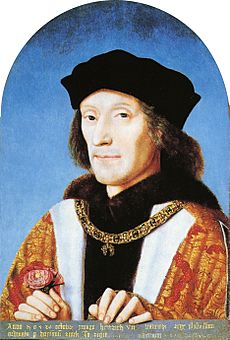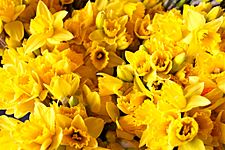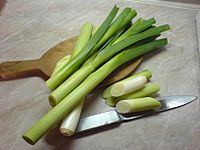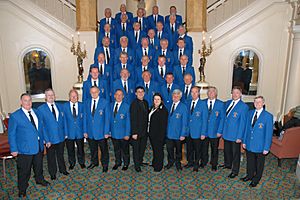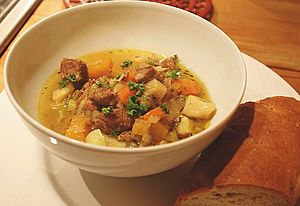Culture of Wales facts for kids
Wales has a distinctive culture including its own language, customs, holidays and music.
Wales is primarily represented by the symbol of the red Welsh Dragon, but other national emblems include the leek and daffodil. The Welsh words for leeks (cennin) and daffodils (cennin Pedr, lit. "(Saint) Peter's Leeks") are closely related and it is likely that one of the symbols came to be used due to a misunderstanding for the other one, though it is less clear which came first.
Contents
Development of Welsh culture
Historical influences
Although Wales has been identified as having been inhabited by humans for some 230,000 years, as evidenced by the discovery of a Neanderthal at the Bontnewydd Palaeolithic site in North Wales, it is the Welsh rulers of the Middle Ages who have proven to be the most influential.
While Rhodri the Great in the 9th century was the first ruler to oversee a large portion of Wales, it was not until 1055 that Gruffydd ap Llywelyn united the individual Welsh kingdoms and began to annex parts of England. Gruffydd was killed by his own men on 5 August 1063 while Harold Godwinson sought to engage him in battle. This was just over three years before the Norman invasion of England, which led to a drastic change of fortune for Wales. By 1070, the Normans had already seen successes in their invasion of Wales with Gwent fallen and Deheubarth plundered. The invasion was seemingly complete by 1093.
However, the Welsh rebelled against their new overlords the following year, and the Welsh kingdoms were re-established and most of the land retaken from the Normans over the subsequent decades. While Gwynedd grew in strength, Powys was broken up after the death of Llywelyn ap Madog in the 1160s and was never reunited. Llywelyn the Great rose in Gwynedd and had reunited the majority of Wales by his death in 1240. After his death, King Henry III of England intervened to prevent Dafydd ap Llywelyn from inheriting his father's lands outside Gwynedd, leading to war. The claims of his successor, Llywelyn ap Gruffudd, conflicted with those of King Edward I of England; this resulted in the conquest of Wales by English forces.
The Tudors of Penmynydd grew in power and influence during the 13th to 15th centuries, first owning land in North Wales, but losing it after Maredudd ap Tudur backed the 1400 uprising of Owain Glyndŵr. Maredudd's son, Owain ap Maredudd ap Tudur, anglicised his name to become Owen Tudor, and was the grandfather of Henry Tudor. Henry took the throne of England following the Wars of the Roses when his forces defeated those of Richard III at the Battle of Bosworth Field. The House of Tudor continued to reign through several successive monarchs until 1603, when James I (James VI of Scotland) took the throne for the House of Stuart; his great grandmother was Margaret Tudor.
Identity and nationalism
Symbols
Official symbols of Wales include the Welsh Dragon, daffodil and leek. Both the dragon and leek date back to the 7th century, as King Cadwaladr of Gwynedd had his soldiers wear the vegetable during battle against Saxons to make it easier to identify them. He also introduced the Red Dragon standard, although this symbol was most likely introduced to the British Isles by Roman troops. It may also have been a reference to the 6th century Welsh word draig, which meant "leader". The standard was appropriated by the Normans during the 11th century, and used for the Royal Standard of Scotland. Richard I of England took a red dragon standard with him on the Third Crusade. The colours of the leek were used for the uniforms of soldiers under Edward I of England.
Both symbols were popular with Tudor kings, with Henry VII of England (Henry Tudor) adding the white and green background to the red dragon standard. It was largely forgotten by the House of Stuart, who favoured a unicorn instead. By the 17th and 18th centuries, it became common practice in Great Britain for the gentry to wear leeks on St. David's Day. In 1807, a "a red dragon passant standing on a mound" was made the King's badge for Wales. Following an increase in nationalism in 1953, it was proposed to add the motto Y ddraig goch ddyry cychwyn ("the red dragon takes the lead") to the flag. This was poorly received, and six years later Queen Elizabeth II intervened to put the current flag in place.
The daffodil is a more recent development, becoming popular during the 19th century. It may have been linked to the leek; as the Welsh for daffodil (cenhinen Bedr) translates as "St Peter's Leek". During the 20th century, the daffodil rose to rival the prominence of the leek as a symbol of Wales. Prime Minister David Lloyd George ensured that the daffodil had a place in the investiture of Edward, Prince of Wales. The traditional Welsh costume and Welsh hat were well known during the 19th and early 20th centuries. Princess Alexandrina Victoria (later Queen Victoria) had a hat made for her when she visited Wales in 1832. The hat was popularised by Sydney Curnow Vosper's 1908 painting Salem, but by then its use had declined.
Language
Religion
. Over 32% of the population in Wales did not note a religion. Research in 2007 by the Tearfund organisation showed that Wales had the lowest average church attendance in the UK, with 12% of the population routinely attending the united church of English wahles.
Festivals
The patron saint of Wales is Saint David, Dewi Sant in Welsh. St. David's Day is celebrated on 1 March, which some people argue should be designated a public holiday in Wales. Other days which have been proposed for national public commemorations are 16 September (the day on which Owain Glyndŵr's rebellion began) and 11 December (the death of Llywelyn ap Gruffudd).
The traditional seasonal festivals in Wales are:
- Calan Gaeaf (a Hallowe'en or Samhain-type festival on the first day of winter)
- Gwyl Fair y Canhwyllau (literally Mary's Festival of the Candles, i.e. Candlemas; also coinciding with Imbolc)
- Calan Mai (May Day, and similar to Beltane)
- Calan Awst (1 August, equivalent to Lammas and Lughnasa)
- Gŵyl Mabsant celebrated by each parish in commemoration of its native saint, often marked by a fair
- Dydd Santes Dwynwen, a Welsh equivalent to St Valentine's Day
- Calennig is a Welsh New Year celebration
Arts
Visual arts
Many works of Celtic art have been found in Wales. In the Early Medieval period, the Celtic Christianity of Wales participated in the Insular art of the British Isles and a number of illuminated manuscripts possibly of Welsh origin survive, of which the 8th century Hereford Gospels and Lichfield Gospels are the most notable. The 11th century Ricemarch Psalter (now in Dublin) is certainly Welsh, made in St David's, and shows a late Insular style with unusual Viking influence.
The best of the few Welsh artists of the 16th-18th centuries tended to move elsewhere to work, but in the 18th century the dominance of landscape art in English art brought them motives to stay at home, and brought an influx of artists from outside to paint Welsh scenery. The Welsh painter Richard Wilson (1714–1782) is arguably the first major British landscapist, but rather more notable for Italian scenes than Welsh ones, although he did paint several on visits from London.
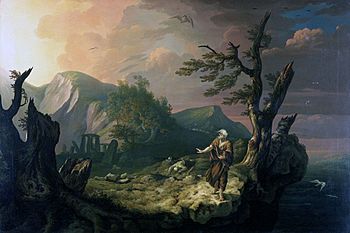
It remained difficult for artists relying on the Welsh market to support themselves until well into the 20th century. An Act of Parliament in 1854 provided for the establishment of a number of art schools throughout the United Kingdom, and the Cardiff School of Art opened in 1865. Graduates still very often had to leave Wales to work, but Betws-y-Coed became a popular centre for artists, and its artists' colony helped form the Royal Cambrian Academy of Art in 1881. The sculptor Sir William Goscombe John made many works for Welsh commissions, although he had settled in London. Christopher Williams, whose subjects were mostly resolutely Welsh, was also based in London. Thomas E. Stephens and Andrew Vicari had very successful careers as portraitists based respectively in the United States and France. Sir Frank Brangwyn was Welsh by origin, but spent little time in Wales.
Perhaps the most famous Welsh painters, Augustus John and his sister Gwen John, mostly lived in London and Paris; however the landscapists Sir Kyffin Williams and Peter Prendergast remained living in Wales for most of their lives, though well in touch with the wider art world. Ceri Richards was very engaged in the Welsh art scene as a teacher in Cardiff, and even after moving to London; he was a figurative painter in international styles including Surrealism. Various artists have moved to Wales, including Eric Gill, the London-born Welshman David Jones, and the sculptor Jonah Jones. The Kardomah Gang was an intellectual circle centred on the poet Dylan Thomas and poet and artist Vernon Watkins in Swansea, which also included the painter Alfred Janes. Today much art is produced in Wales, as elsewhere in a great diversity of styles.
Ceramics
Historically, there were three main areas of pottery production in Wales: south-west Wales, northern Monmouthshire and the Vale of Glamorgan. Several further sites can be identified through their place names, for example Pwllcrochan in Pembrokshire, which translates to Crock Pool, and archaeology has also revealed former kiln sites across the country. These were often located near clay beds, for ease of resource gathering. Buckley and Ewenny became leading areas of pottery production in Wales during the 17th and 18th centuries; these are applied as generic terms to different potters within those areas during this period. South Wales had several notable potteries during that same period, an early exponent being the Cambrian Pottery (1764–1870, also known as "Swansea pottery"). The works from Cambrian attempted to imitate those of Wedgwood. Nantgarw Pottery, near Cardiff, was in operation from 1813 to 1823 making fine porcelain. Llanelly Pottery was the last surviving major pottery works in South Wales when it closed in 1922.
Literature
Theatre
Theatrical performances are thought to have begun after the Roman invasion of Britain. There are remains of a Roman amphitheatre at Caerleon, which would have served the nearby fortress of Isca Augusta. Between Roman and modern times, theatre in Wales was limited to performances of travelling players, sometimes in temporary structures. Welsh theatrical groups also performed in England, as did English groups in Wales. The rise of the Puritans in the 17th century and then Methodism during the 18th century caused declines in Welsh theatre as performances were seen as immoral.
Despite this, performances continued on showgrounds, and with a handful of travelling groups of actors. The Savoy Theatre, Monmouth, the oldest theatre still in operation in Wales, was built during the 19th century and originally operated as the Assembly Rooms. Other theatres opened over the following decades, with Cardiff's Theatre Royal opening in 1827. After a fire, a replacement Theatre Royal opened in 1878. Competition for theatres led to further buildings being constructed, such as the New Theatre, Cardiff, which opened on 10 December 1906.
Television
Film
Music
Wales is often referred to as "the land of song", and is notable for its harpists, male choirs, and solo artists. The principal Welsh festival of music and poetry is the annual National Eisteddfod. The Llangollen International Eisteddfod echoes the National Eisteddfod but provides an opportunity for the singers and musicians of the world to perform. Traditional music and dance in Wales is supported by many societies. The Welsh Folk Song Society has published a number of collections of songs and tunes.
Male choirs (sometimes called male voice choirs), which emerged in the 19th century, have remained a lasting tradition in Wales. Originally these choirs were formed as the tenor and bass sections of chapel choirs, and embraced the popular secular hymns of the day. Many of the historic Welsh choirs survive, singing a mixture of traditional and popular songs. Traditional instruments of Wales include telyn deires (triple harp), fiddle, crwth, pibgorn (hornpipe) and other instruments. The Cerdd Dant Society promotes its specific singing art primarily through an annual one-day festival. The BBC National Orchestra of Wales performs in Wales and internationally. The Welsh National Opera is based at the Wales Millennium Centre in Cardiff Bay, while the National Youth Orchestra of Wales was the first of its type in the world.
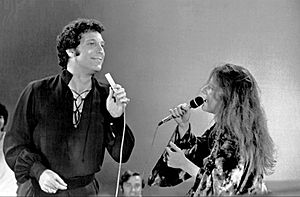
Wales has had a number of successful singers across the decades. In the 1960s, bands such as Amen Corner, The Iveys/Badfinger and singers including Sir Tom Jones, Dame Shirley Bassey and Mary Hopkin. By the 1980s, indie pop and alternative rock bands such as The Alarm, The Pooh Sticks and The Darling Buds were popular in their genres. But the wider view at the time was that the wider Welsh music scene was stagnant, as the more popular musicians from Wales were from earlier eras.
In the 1990s, in England, the Britpop scene was emerging, while in Wales, bands such as Y Cyrff and Ffa Coffi Pawb began to sing in English, starting an evolution that would lead to the creation of Catatonia and the Super Furry Animals. The influence of the 80s bands and the emergence of a Welsh language and dual language music scene locally in Wales led to the a dramatic shift in opinion across the United Kingdom as the "Cool Cymru" bands of the period emerged. The leading Welsh band during this period was the Manic Street Preachers, whose 1996 album Everything Must Go has been listed among the greatest albums of all time.
Some of those bands have had ongoing success, while the general popularity of Welsh music during this period led to a resurgence of singers such as Tom Jones with his album Reload. It was his first non-compilation number one album since 1968's Delilah. Meanwhile, Shirley Bassey reached the top 20 once more in the UK Charts with her collaboration with the Propellerheads on the single "History Repeating". They also introduced new acts, such as Catatonia's Owen Powell working with Duffy during her early period. Moving into the 21st century, Bullet For My Valentine were named the Best British Band at the Kerrang! Awards for three years running. Other successful bands from this period include Funeral For A Friend, and Lostprophets.
Cuisine

Wales is not considered to have a strong food identity, with some people considering that there is "no such thing as Welsh food". Welsh cookery is said to be similar to English Cuisine in style. However, there are regional variations in the food seen across Wales, which can be traced historically to the availability of certain crops and produce in specific areas of the country. The cuisine of Gower is particularly different to the rest of Wales. It was strongly influenced by Somerset and Devon, and developed dishes such as whitepot while ingredients such as pumpkin were used, which are unusual in the rest of Wales.
Cattle farming produces the majority of Wales' agricultural output. Welsh beef is protected under European Union law, meaning that it must be produced and slaughtered in Wales. Welsh pigs are raised, providing good cuts of meat. The mountainous areas of Wales are suited to sheep farming and this has led to an association of their meat with the country. The mutton of Wales has been popular in the rest of the United Kingdom since the 16th century, and by the end of the 20th century there were more than 11 million sheep in Wales.
Several Welsh dishes are thought of because their ingredients are associated with Wales, whereas others have been developed there. Cawl is regarded as the Welsh national dish; it is a slow-cooked meat and vegetable broth. Traditionally it was a vegetable-heavy dish, but now it is more likely to contain beef or lamb. Welsh rarebit is thought to date from the 18th century, although the original term "Welsh rabbit" may have been intended as a slur against the Welsh. Another use of cheese in a traditional Welsh dish is seen in Glamorgan sausage, which is a skinless sausage made of cheese and either leek or spring onion, which is then rolled into a sausage shape before frying. Laverbread is made using a puree of seaweed, and is traditionally served with a Welsh breakfast. Welsh cakes are made on a bakestone, and are small round spiced cakes containing raisins, sultanas and occasionally currants. Bara brith contains similar ingredients to Welsh cakes, but is similar to a tea bread.
Beer is the national drink of Wales, despite the influence of the temperance movement in Wales. The Wrexham Lager Beer Company was the first successful lager producer in Britain when it opened in 1882 and the Felinfoel Brewery was the first brewery in Europe to put beer in cans. Whisky production in Wales was historically a niche industry, and completely shut down in 1910 when the last distillery was bought out by a Scottish firm. However, the Penderyn distillery became the first Wales-created whisky in a century to go on sale when it was launched in 2004. There are 20 Welsh vineyards producing 100,000 bottles of wine a year in total.
Images for kids
-
Owain Glyndŵr painting by AC Michael.
-
Medieval crwth instrument


